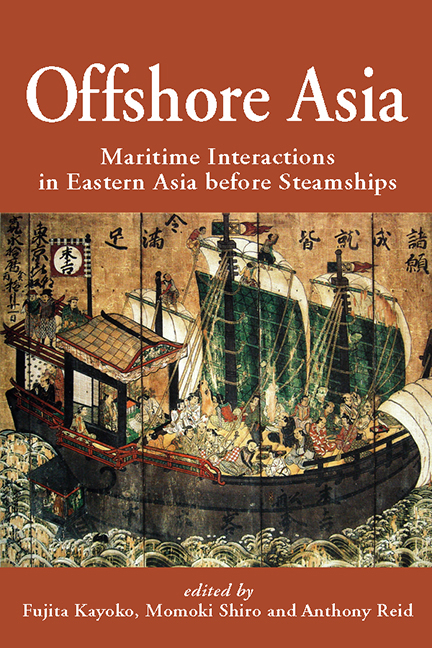Book contents
- Frontmatter
- Contents
- Maps
- Tables and Figures
- Preface
- Contributors
- Map 1 Eastern Asia in the 13th–16th Centuries
- 1 Introduction: Maritime Interactions in Eastern Asia
- 2 The Periodization of Southeast Asian History, in Comparison with that of Northeast Asia
- 3 Merchants, Envoys, Brokers and Pirates: Hokkien Connections in Pre-modern Maritime Asia
- 4 An Asian Commercial Ecumene, 900–1300 ce
- 5 The Japanese Archipelago and Maritime Asia from the 9th to the 14th Centuries
- 6 Saltpetre Trade and Warfare in Early Modern Asia
- 7 Shaping Maritime East Asia in the 15th and 16th Centuries through Choson Korea
- 8 Shipwreck Salvage and Survivors’ Repatriation Networks of the East Asian Rim in the Qing Dynasty
- 9 Wei Zhiyan and the Subversion of the Sakoku
- 10 Metal Exports and Textile Imports of Tokugawa Japan in the 17th Century: The South Asian Connection
- Bibliography of Works Cited
- Index
- NALANDA-SRIWIJAYA SERIES
2 - The Periodization of Southeast Asian History, in Comparison with that of Northeast Asia
Published online by Cambridge University Press: 21 October 2015
- Frontmatter
- Contents
- Maps
- Tables and Figures
- Preface
- Contributors
- Map 1 Eastern Asia in the 13th–16th Centuries
- 1 Introduction: Maritime Interactions in Eastern Asia
- 2 The Periodization of Southeast Asian History, in Comparison with that of Northeast Asia
- 3 Merchants, Envoys, Brokers and Pirates: Hokkien Connections in Pre-modern Maritime Asia
- 4 An Asian Commercial Ecumene, 900–1300 ce
- 5 The Japanese Archipelago and Maritime Asia from the 9th to the 14th Centuries
- 6 Saltpetre Trade and Warfare in Early Modern Asia
- 7 Shaping Maritime East Asia in the 15th and 16th Centuries through Choson Korea
- 8 Shipwreck Salvage and Survivors’ Repatriation Networks of the East Asian Rim in the Qing Dynasty
- 9 Wei Zhiyan and the Subversion of the Sakoku
- 10 Metal Exports and Textile Imports of Tokugawa Japan in the 17th Century: The South Asian Connection
- Bibliography of Works Cited
- Index
- NALANDA-SRIWIJAYA SERIES
Summary
FRAMEWORK OF COMPARISON
This chapter aims at reviewing the periodization of Southeast Asia from the 9th century to the mid-19th century in comparison with that of Japan, and sometimes of Korea and China. The authors prefer the term Northeast Asia to the more usual East Asia for the three countries, and in some cases are inclined to regard southern China as part of Southeast Asia. We focus on the common features of East Eurasian rimlands. It will help readers grasp wider (in terms of both time and space) economic and social trends, in which maritime interactions examined in the following chapters took place. Southeast Asianists often pay attention to common features or the entire composition of the region. Generally speaking, however, Southeast Asian historical studies are indifferent to the periodization of regional history. Serious challenges to the ahistorical dichotomy of Ancient/Modern or Traditional/Modern Southeast Asia have only recently appeared, despite the early proposition of Benda's “The Structure of Southeast Asian History”. On the other hand the historiography of Northeast Asia, led mostly by scholars in the region, is often nation-state oriented. But it is more conscious of periodization, whether it is done to trace negative “premodern” or “feudal” pasts, or to find positive “preludes” or “embryos” of modernity. There are ample arguments about continuities and changes among various historical stages, and standards of periodization as well. For this reason, Northeast Asian and Southeast Asian studies can be supplementary to each other.
Nevertheless, the scope of Southeast Asianists in relation to the northern direction usually covers only China, while peripheral areas of Northeast Asia like the Korean Peninsula and the Japanese Archipelago are often overlooked. Most Japanologists and Koreanists in their turn are far less interested in Southeast Asia than in China. In this context, Lieberman's comparisons of mainland Southeast Asia, Japan and China, focussing on the major steps of state consolidation, are quite challenging. He drew a picture of Eurasia as a whole, distinguishing the “protected zone” (much of Europe, Southeast Asia, and Japan) from the “exposed zone” (China, most of South Asia, and Southwest Asia) strongly influenced by Inner Asia. This distinction reminds Japanese readers of the “ecohistory of civilizations” proposed by Umesao Tadao.
- Type
- Chapter
- Information
- Offshore AsiaMaritime Interactions in Eastern Asia before Steamships, pp. 16 - 52Publisher: ISEAS–Yusof Ishak InstitutePrint publication year: 2013



